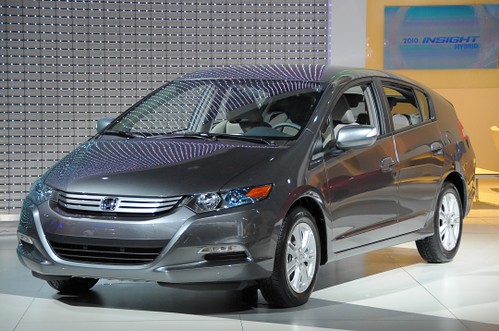Yazaki, J1772, the Europeans and the new charging order.
Last week at the 2009 SAE World Congress the final plans were bashed out for a new way to charge plug in vehicles. Sadly it’s not an inductive one like the oh-so-simple charge paddles which were used on cars like the EV1 and RAV4EV to name but a few. No, this new standard is a good old-fashioned mechanical plug. You plug your car in and up to 30 Amps at either 120 or 240V flows into your car. Neat.
The latest version of the charging standard, called J1772, will include a five prong plug, capable of allowing communication between the external charger and the car charging. The Volt is rumored to be using it and Tesla have already signed up to make it standard on their cars. But it’ll only be used in the USA. Europe, in it’s own special way, has gone a different route, with a three-prong design capable of up to 80Amps at 240V. Unfortunately, the European standard is three-phase, meaning that it is unlikely to work in most European domestic situations without a complete home re-wire.

Fast charging is great, but does this spell the end for the DIY converter, or those of us who already drive cars with standard domestic plugs? And when you scratch the surface we risk looking at a future where charging plugs are far from standard. With the European standard and US standard finalized, are car companies now going to play nice and only ever use one of two EV charging plugs. What about cross-continent imports? And will those of us with cars now be able to retrofit our cars?
Yazaki, J1772, the Europeans and the new charging order.
Last week at the 2009 SAE World Congress the final plans were bashed out for a new way to charge plug in vehicles. Sadly it’s not an inductive one like the oh-so-simple charge paddles which were used on cars like the EV1 and RAV4EV to name but a few. No, this new standard is a good old-fashioned mechanical plug. You plug your car in and up to 30 Amps at either 120 or 240V flows into your car. Neat.
The latest version of the charging standard, called J1772, will include a five prong plug, capable of allowing communication between the external charger and the car charging. The Volt is rumored to be using it and Tesla have already signed up to make it standard on their cars. But it’ll only be used in the USA. Europe, in it’s own special way, has gone a different route, with a three-prong design capable of up to 80Amps at 240V. Unfortunately, the European standard is three-phase, meaning that it is unlikely to work in most European domestic situations without a complete home re-wire.

Fast charging is great, but does this spell the end for the DIY converter, or those of us who already drive cars with standard domestic plugs? And when you scratch the surface we risk looking at a future where charging plugs are far from standard. With the European standard and US standard finalized, are car companies now going to play nice and only ever use one of two EV charging plugs. What about cross-continent imports? And will those of us with cars now be able to retrofit our cars?
Identity Insight Crisis
Given the nice weather we’ve been having here in the UK for the past few days I thought I’d take advantage of some rare spare time and head to the local Honda garage today to see if I could test-drive the new Honda Insight. I went incognito, sans camera, to see if I could get a real feel for how the dealership, and the Insight, performed.

What I found was a very fuel efficient car with a confused soul. Somewhere between drawing board and final model, the new Insight feels like a car unsure of what it really is. I’m quite sure it will find a market, but it feels like Honda have tried so hard to please everyone that they’ve managed to produce a car which doesn’t please anyone.
Identity Crisis?
Given the nice weather we’ve been having here in the UK for the past few days I thought I’d take advantage of some rare spare time and head to the local Honda garage today to see if I could test-drive the new Honda Insight. I went incognito, sans camera, to see if I could get a real feel for how the dealership, and the Insight, performed.  What I found was a very fuel efficient car with a confused soul. Somewhere between drawing board and final model, the new Insight feels like a car unsure of what it really is. I’m quite sure it will find a market, but it feels like Honda have tried so hard to please everyone that they’ve managed to produce a car which doesn’t please anyone.
What I found was a very fuel efficient car with a confused soul. Somewhere between drawing board and final model, the new Insight feels like a car unsure of what it really is. I’m quite sure it will find a market, but it feels like Honda have tried so hard to please everyone that they’ve managed to produce a car which doesn’t please anyone.
Is 12 miles enough?
Earlier this week, various reports surfaced detailing Toyota’s plans to release the 2010 Prius as PHEV, but only to fleet customers. The range? A shade over 12 miles (20 km).
While it’s good to see Toyota going towards a Plug in Prius, it’s a little frustrating to see a small PHEV range when compared to the commercial and DIY conversion options out there for the current Prius. It’s also a little frustrating to see that Toyota only plans to sell the PHEV prius to fleets rather than individuals. Is that the right choice? And is 12 miles EV only range enough?

Photo by Swimfinfan, reproduced under creative commons license.
Is 12 miles enough?
Earlier this week, various reports surfaced detailing Toyota’s plans to release the 2010 Prius as PHEV, but only to fleet customers. The range? A shade over 12 miles (20 km).
While it’s good to see Toyota going towards a Plug in Prius, it’s a little frustrating to see a small PHEV range when compared to the commercial and DIY conversion options out there for the current Prius. It’s also a little frustrating to see that Toyota only plans to sell the PHEV prius to fleets rather than individuals. Is that the right choice? And is 12 miles EV only range enough?

Photo by Swimfinfan, reproduced under creative commons license.
Sorry. No post today
Sorry. No post today
Could falling speed limits in UK help town EVs?
Those red-blooded, meat-eating petrol-heads aren’t going to like today’s motoring news from the UK; The Government is planning to reduce the speed limit of some UK roads to help reduce fatal crashes, improve fuel economy for drivers and reduce pollution. The reductions? The national limit on single-lane (one lane in each direction) roads could be lowered from 60mph to 50mph in rural locations – and the normal town speed limit of 30mph in built-up areas could be reduced to 20mph.
According to this times article, local councils wishing to keep the current speed limits would have to make some seriously impressive cases to be allowed to keep the current 60mph and 30 mph limits. There’s no plans to reduce the speed limit on major roads such as dual carriageways and motorways. That will stay at 70mph.
The idea behind it all of course is to make roads safer and reduce death and serious injury in the next ten years by a substantial amount. Will it be obeyed? Or will it just mean more fines for unfortunate drivers caught out by confusing (and changing) speed limits?
Or is there another effect of this announcement which some of us may actually benefit from in other ways?
